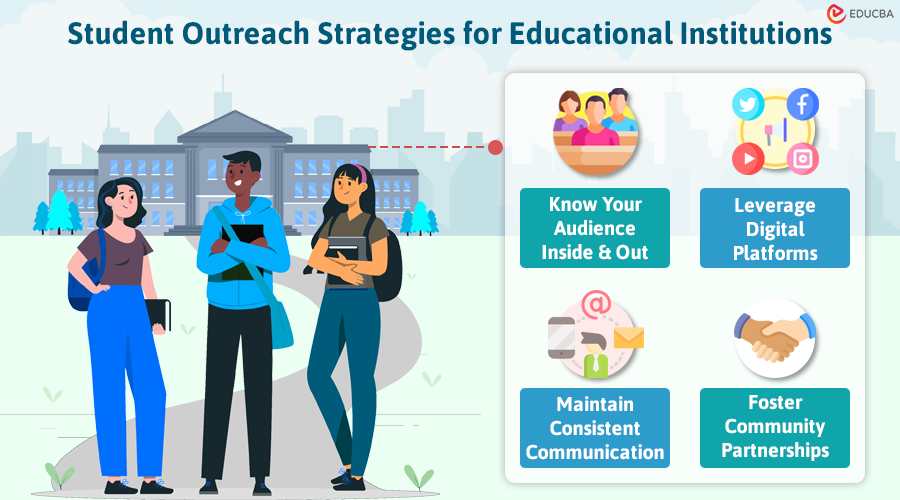
What are Student Outreach Strategies?
Educational institutions use student outreach strategies, like social media and campus events, to connect with students and encourage them to apply.
Many schools struggle to engage potential students, often because they don’t have a clear outreach plan. However, some schools, like Delphian School in Sheridan, Oregon, have overcome this obstacle and built strong community connections. They have learned how to communicate well with students, families, alumni, and other key groups.
Essential Student Outreach Strategies
Here are four student outreach strategies that can help your school build lasting connections.
1. Know Your Audience Inside and Out
Understanding who you are trying to reach is the cornerstone of effective outreach. Your audience is a diverse group with varying needs and interests.
Start by identifying key demographics, such as:
- Prospective students
- Parents
- Alumni
- Community members
Each group has its own needs and interests as follows:
- Prospective students focus on career opportunities and campus life.
- Parents prioritize academic quality and safety.
- Alumni may be more interested in networking and maintaining a connection with the school.
- Community members value local partnerships and engagement.
How to identify your audience’s needs:
- Analyze data: Use website analytics, social media engagement, and event attendance data to track what matters most to each group.
- Survey your audience: Ask for feedback through polls and surveys.
This information can reveal patterns in behavior and preferences, allowing you to tailor your approach.
2. Leverage Digital Platforms
As most outreach happens online, institutions must use digital platforms to connect with students. Here’s how each platform can serve your school:
| Platform | Best Used For | Example |
| Sharing quick updates, real-time conversations | Delphian School uses Twitter to share student stories, alumni updates, and campus photos. | |
| Long-form content, community building. | The University of Michigan engages 800,000 followers with academic and alumni success stories. | |
| Showcasing visual content like campus life and student achievements | UCLA posts football photos, campus activities, and short speeches to its 440,000 followers. | |
| Professional networking and highlighting alumni success | Stanford connects 1 million followers with job opportunities, research breakthroughs, and industry insights. |
Best practices for digital engagement:
- Keep your educational institution visible by regularly updating all platforms
- Your website and blog also serve as central hubs for engaging content.
- Share student success stories, highlight alumni achievements, and feature current projects.
- Personal narratives and testimonials can be particularly powerful.
- Email is still relevant and can be very effective when done right. In fact, A survey by Carnegie Higher Ed found that 57.8% of students want to receive emails from a single institution either once a week or once every two weeks.
3. Maintain Consistent Communication
To keep your institution top of mind, communication must be consistent. Engaging your audience through various channels helps build strong relationships over time.
Adopt a multichannel approach:
- Email newsletters: These are perfect for delivering detailed updates and stories straight to inboxes.
- Social media updates: Quick, engaging posts on platforms like Instagram and Twitter can keep your followers in the loop with real-time news.
- Traditional direct mail (for certain segments): Yes, it still has its place, especially for those who appreciate a tangible connection.
The key is to maintain a cohesive message across all these channels. Adapt the format to suit each platform, but make sure that your core message remains consistent. Consider leveraging modern communication tools like mobile push notifications and in-app messaging. These can help you reach students where they’re most active, making your updates more immediate and relevant.
Incorporate feedback loops:
- Consider incorporating surveys and polls within your communications to gather valuable insights.
- Encourage your audience to share their thoughts.
4. Foster Community Partnerships
Collaborations with local businesses, organizations, and alumni can amplify your outreach efforts significantly. You can also identify potential partners whose values align with your mission.
Develop mutually beneficial relationships:
- Collaborative events
- Shared resources
- Joint community initiatives
According to the National Center for Education Statistics, 64% of all public schools in the United States had students participating in community service activities recognized by or arranged through the school during the 1998-99 school year. High schools were particularly active, with 83% of them having students engaged in such activities. Private schools like Delphian make community engagement and volunteering central to student activity. For example, one of their recent online magazines featured stories of students volunteering at a local Salvation Army food pantry and at a free community breakfast program.
Don’t overlook your alumni network:
Engaged alumni can be your most authentic ambassadors. Create opportunities for them to connect with current and prospective students, share experiences, and contribute to your institution’s growth.
Final Thoughts
Remember, effective outreach is an ongoing process that requires continuous adaptation. An engaging outreach program can support long-term success. However, you must refine your approach based on feedback and results and stay open to new ideas and technologies.
Recommended Articles
If you found this article on “Student Outreach Strategies” helpful, consider reading the following recommendations.

